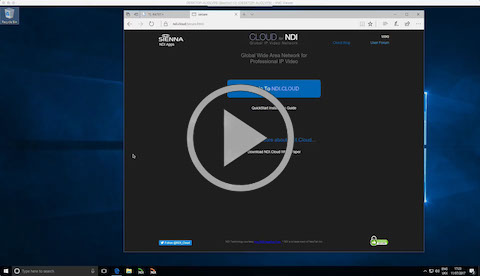
CLOUD for NDI
global ip video network
Sienna Cloud Blog #2
Testing very low end hardware and rapid setup
Todays experiments are to see how quickly we could add a node to an Cloud for NDI network, and whether we can do it with a very low performance device.
The device we are testing is the Beelink AP34 mini PC with an Intel Celeron N3450 CPU at 1.1 to 2.2 GHz. Realistically we are not expecting this to work very well at all - but that's the point of testing it.
The Beelink AP34 is a really tiny box which costs very little (around $200) but comes with a 64 bit processor, 4GB Ram and 64GB of flash with USB3 ports, Gigabit Ethernet and preinstalled Windows 10. it's also fanless which is nice.

Installation Speed
The first test is how quickly we can add a new node to our existing Cloud for NDI network.
The tasks we need to perform are:
1) Determine the machine's local IP address
2) Make a Router Port Forwarding assignment from the site's public IP address into the Beelink.
3) Log In to NDI.Cloud
4) Create a new NODE and enter the details of this machine
5) Add this new NODE to our existing GROUP
6) Download the Node Gateway Software
7) Run the Node Gateway Software, and select this node, hit Download Device to install identity.
8) Restart the Node Gateway and check it's communicating
In practice it took just over 3 minutes (less than 200 seconds !!) to perform these steps to go from zero to a fully connected Node on our existing NDI.Cloud network. At this point we can send and receive video from this node.
If you want to watch all 3 minutes 16 seconds of the rapid setup, click on the movie below

Performance testing
As stated, this is a very low powered machine and we are not expecting much. Also, Windows 10 is not supported in Cloud For NDI at present due to receiving performance issues.
The first test is to use it as an NDI.Cloud receiver, sending video from another node into this one and viewing the results on a different machine (so this Beelink machine is just used for the receiving part).
Result :
Whilst it technically works, the performance is poor and we only achieve about 8 frames per second with an HD signal. FAIL. This is probably more to do with the general issues with Windows 10, so we will test this again with windows 7 and Ubuntu later.
The second test is to use this as an NDI.Cloud sender, picking up an NDI stream from another local machine and sending it out across the NDI.Cloud network for receipt by another node
Result:
This actually worked OK. I think the machine is really at the limits of its performance but in this test it did deliver a 30 fps test video stream with acceptable performance. Remember that whilst it can only deliver 1 stream, it could be advertising all the NDI feeds in the LAN, and from the receiving end a single one can be selected at a time for playback. In this way a humble machine like this can be used as a selective remote monitor of sources for an entire NDI local network... (just one at a time..)
On a side note, we also tested this machine as an NDI Monitor, using it to pick up a local NDI stream and display it full screen via the HDMI out. For this purpose it works very well.
We also tested using the Beelink AP34 as a single channel video server, using VLC with the NDI output plug in to play HD videos off the internal storage and out via NDI. This test also worked well. For reference the Source video file was the H.264 1080 version of the Buck Bunny test material. We did not test with other source material which may be more CPU intensive for VLC to play.
Conclusion
All in all its handy little device. Its not really very useful for NDI.Cloud operations except perhaps as an emergency extra node to send a leftover source you cant quit fit on your main rig - perhaps a scoreboard view - but it will surely come in handy for use as an NDI Monitor or for playback of a video source as NDI.
What we also learned today, is just how quickly you can expand your Cloud for NDI SDVN (Software defined video network), adding an extra node in as little as five minutes. This ability to rapidly and dynamically create nodes (even via remote access) is an area where Cloud for NDI is breaking new ground for next generation global video companies.